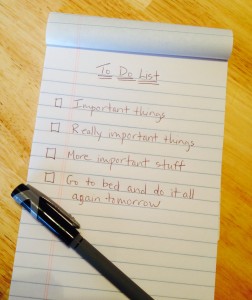 Yes (sigh), I took a little break. Okay, I took a long break.
Yes (sigh), I took a little break. Okay, I took a long break.
It all started during Lent when I went on a time-consuming cleanse diet and found I needed to 86 just about every other responsibility in my life in order to have time to chop copious amounts of veggies for the required daily soups, shop for obscure smoothie ingredients, and make entire meals from scratch (watch the judgments here, people; I know you’ve heated up your share of frozen meals).
Then, when the cleanse was over, I found I actually enjoyed having more space in my life (as some of you know from a past blog post, I can be just the teensiest bit tied to what my husband not-so-fondly refers to as the “tyranny of my todo list”) and so I sort-of-decided to, sort-of-defaulted to, not write for just a bit longer.
That’s how what started out as a brief pause in my writing routine quickly became an out-of-sight-out-of-mind, Grand Canyon-sized rift, so much so that when I finally decided it was time to get back in the writing saddle, it was no longer clear to me how to get from here (no writing discipline) to there (butt in chair assuming the writing position) without a team of donkeys, a hunky cowboy guide and a good pair of hiking boots.
You see, it seemed like there was always something I simply HAD to do first. Like reorganize my shoes. Or find out the exact chronological order of the Jack Reacher novels. Or clean the crumbs out of that little tray that sits under the toaster oven. Or read about this cute little pet tortoise that went missing for 30 years.
I have actually had all of these items on my todo list. I know. I’m hopeless.
Enter my friend, Polly, and her generous invitation to participate in something called a blog hop. THANK YOU, POLLY! Your invite was just the kick in the butt I needed. I owe you big.
Polly is a writer and teacher and all around stellar person who lives with her family in New Hampshire. Her husband is a priest (now a bishop) in the Episcopal Church, and Polly writes from the perspective of a priest’s (now a bishop’s) wife who came late to organized religion. She writes about the intersection of matters both sacred and secular, which means she writes about A LOT OF THINGS. And she does so beautifully and thoughtfully.
I have actually only met in-the-flesh Polly one time, but I feel I know her well because of her posts. That’s the way her posts are. Check them out here. And then come back to my post, because I’m not done yet.
Note/Warning/Disclaimer: The blog hop invite came with some specific questions for me to answer. It’s also a pretty long post for me. Those of you who are used to my usual content and format may notice a difference; the rest of you will be blissfully unaware that something new is going on, so never mind.
And so, without further ado, I present my official, tired-of-being-a-lazy-bum, back in the saddle, let’s get on with it people . . . blog hop post.
Blog Hop Post
So what exactly is a blog hop? I know. I didn’t know either. Frankly, I’m pretty sure this was the first time Polly had heard of one as well. So you are in good company.
Hopefully that will change, because it turns out this blog post thing is kind of fun. The way it works is that one person writes a post on a particular topic of their choosing, in the body of which they give a shout-out to three other bloggers. Those three bloggers then write on the same topic on their own blog, tag three more bloggers, and so on, and so on. Wash, rinse, repeat.
It’s kind of like a pyramid scheme but without the scheming.
This particular blog hop’s questions are about writing, a topic that has (as you now know) been on my mind a lot lately. So here I go . . .
Question #1: What am I writing/working on?
- I write this blog. Or at least I used to. I took a big break, but now I’m writing again.
- I am also writing a book of personal essays about vulnerability, which I hope will some day be published.
- I sometimes write poetry. I don’t think it’s very good poetry, but I REALLY enjoy writing it and so I do.
Question #2: How does my work differ from others in its genre?
Up until now, I hadn’t given much thought to my blog’s genre, so I had to do some research in order to answer this question. Turns out my blog is what’s called a professional blog, in that it is one aligned with my profession (I’m a psychotherapist). Yes, I suppose I could’ve figured this out without the research.
Actually, now that I’m an expert in these things, I would say my writing straddles two different genres, the professional and the personal, which might make my blog stand out from some others that are similar.
See, as far as content goes, I don’t believe my blog differs much from other blogs written by therapists. I write about relationships, grief, communication, balance, mindfulness, self esteem, change . . . you get the picture.
But when I think about my perspective, the lens through which I explore and write about these issues . . . here I think I’m a bit different.
Because in my writing, as in my therapy work, I always try to be mindful that I am, by virtue of being a freakishly imperfect human being, just as vulnerable to the same kinds of worries, distress, confusions and mistakes as those my clients experience.
And, so, knowing this – on some days with what feels like 110% certainty – I always TRY to write (posts, essays and poetry) from a vulnerable, we’re-all-in-this-together kind of place, and in doing so attempt to be as transparent about my own foibles as I have the courage to be.
That courage fluctuates from day to day, of course, a dynamic you will notice as you peruse my posts. But I am really always trying for authenticity. I really am.
Question #3: Why do I write what I write?
A year or so ago I was invited to contribute a writing prompt to a book about how writing can help you get through difficult times in your life.
For my contribution, I wrote what was, and always has been, the truth for me, that “writing helps me sort through the hoarder’s mess of thoughts and feelings that are me, and find the words that will help me both know myself and share myself with others. I sometimes don’t even know what I think until I read what I write.”
So my writing, whether it be a blog post about letting go, a book of essays about vulnerability, or a poem about an old hinge (I told you my poetry isn’t very good) is, at its core, about getting to know a part of me a little better, and then – hopefully – connecting that part of me with a part of you.
Question #4: How does my writing process work?
Very haltingly, and with great gnashing of teeth.
No, really. Like many writers, I often find it difficult to actually write. So during my morning computer time, I am super good at finding multiple and varied (would it be bragging to say creative?) ways of distracting myself from what I came to do.
I check email and Facebook. I straighten my desk. I get a drink of water, stare out my window, worry and write something on my to-do list. I bold and italicize my titles, check the clock and stare out my window again. Then, just maybe, I write a sentence or two.
There you have it. There is no wizard behind the curtain. Transparency at its finest.
Question #5: My future blog plans:
To have my blog discovered by the public and go viral. Duh.
Okay, but really . . .
One of the happy consequences of taking this recent luxurious break from the keyboard is that I have some ideas about how I’d like to change things around a bit.
First things first, I want to actually write on a regular basis again. Otherwise, as Anne Lamott is fond of saying, God will give all the good ideas to her.
Then, as I begin to write again, I know I want to do so in a less tutorial, less organized (REALLY hard for me) and more creative way. I don’t know exactly what this will look or feel like. I’ll be stabbing in the dark for a while, I think.
I also know I want to be even more authentically my sometimes sad and bewildered, and always imperfect, self. Many of my days are hard. I do not have all the answers and don’t want to pretend that I do. But I can tell my story in the hope that it intersects with yours and that we can both find our way together.
Finally, the above viral goal notwithstanding, I also want to try to write mostly about what really matters to me, not just about topics I think and hope will be noticed by my social media audience.
I’m hoping all five of my followers will be down with that.
Three Cool Blogs – Tag, You’re It!
Now for my shout-outs to some other bloggers, so that you can hop over to them and enjoy their takes on things:
Jason Emerson is the rector of a small but mighty Episcopal church in Omaha, NE. He has made it his practice to edit his sermons every Thursday at his favorite watering hole, and has issued an open invitation for any and everyone to join him there as he writes and sips. His weekly blog, Fermenting the Word, has become a wonderful merging of all things sacred, social and sudsy (and, yes, he reviews the beer he drinks each week). You can find Father Jason’s writing here.
Fletcher and Adrian decided to take a semester away from the known environment of their liberal arts college and travel for the sake of traveling. At We Float On, they blog about their experiences with new cultures and peoples, travel worries and triumphs, unexpected gifts and the comfort of companionship. Visit them here and, just for a moment, see the world through the open, thoughtful eyes of a young person receptive to all of what life has to offer.
Reka Kluver is a marriage and family therapist in private practice in Omaha, NE. Her posts, about such issues as family stress, domestic violence, grief and loss, depression and anxiety (and the list goes on), are written with wisdom and compassion, and will give you hope and a sense of perspective regardless of your situation. You can find Reka’s advice here on her professional website.
Okay, that’s all for now. Be sure to check out my blogger friends above, and then check back here for more from me. Or, better yet, sign up to follow me (see that little Follow prompt down there?) and avoid the hassle of looking me up; I’ll send my posts straight to your inbox.
More to come! Oh, the pressure.





























